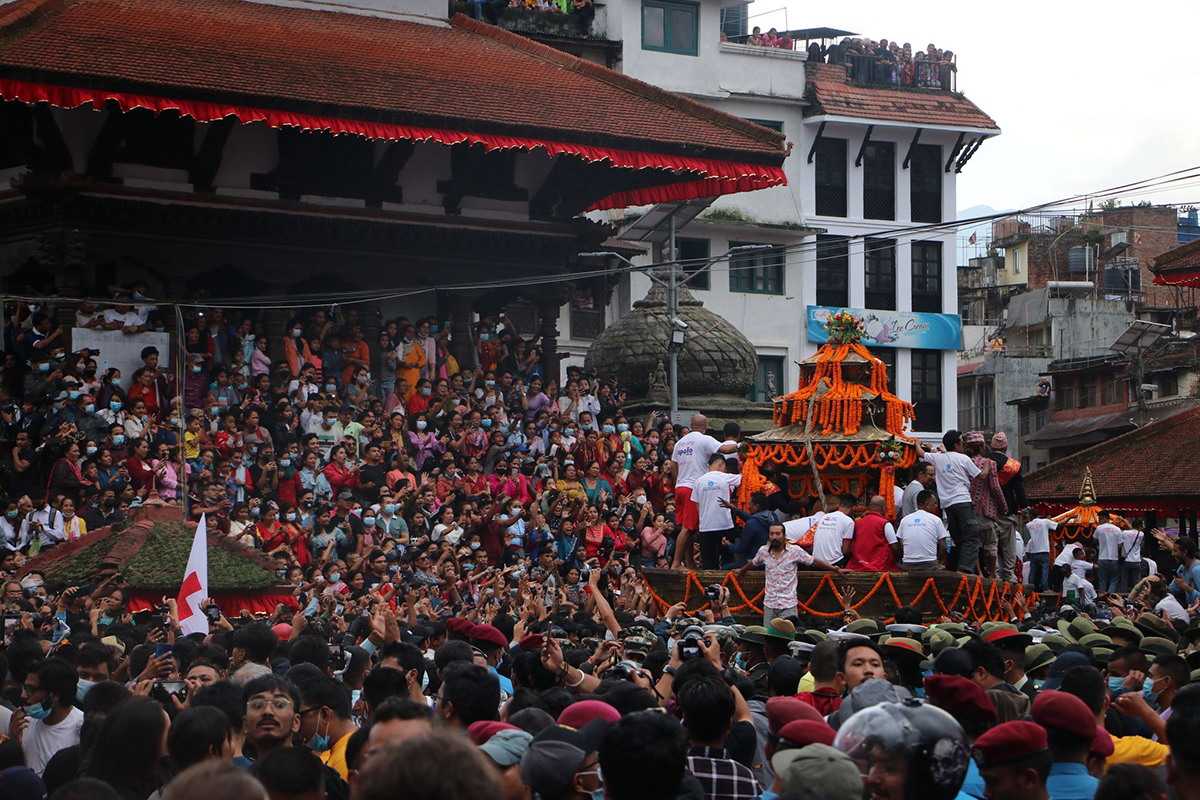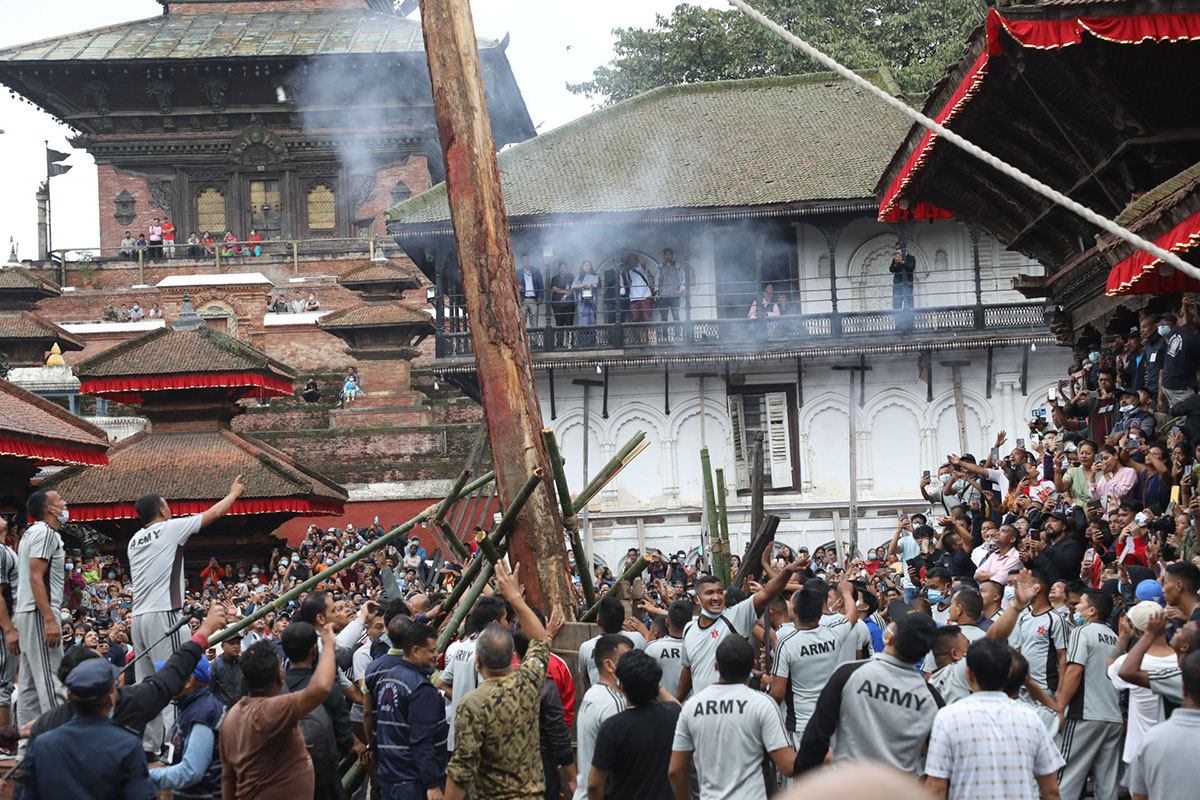
- 2 years ago | 2022-09-28
- Jugal Himal
Indra Jatra
Indra Jatra is one of the longest Newari festival celebrated in Kathmandu valley. The eight days long festival is also called Yenya in Newari language, which is almost a big street festival that is celebrated around world. It has basically two parts as special occasions that is Indra Jatra and Kumari Jatra. Indra Jatra is showcased in the square of Hanuman Dhoka, Basantapur to honor Lord Indra the ruler of heaven. A masked cover deity and demon dances to display the holy images of gods and honor Indra dev.
The festivals has long historical legacy and traditions which were begun by King Guna Kamadev of Kathmandu in the 10th Century. There are several myths and stories regarding Indra Jatra. The logical one is Kathmandu valley is fertile land for agricultural work. And it is believed in Hindu religion, Indradev is god of rain. To respect and pay homage to Indradev, people started to celebrate Indra Jatra for timely rain for planting rice.
Likewise, Kumari jatra is the Chariot procession of living goddess Kumari. Nepal is only one country in the world worship living goddess in the form of Kumari. Kumari is a prepubescent girl from Shakya caste from Newari buddhist family. It is believed that the supernatural power of Goddess Durga resides in Kumari. Indra Jatra is normally celebrated in the month of September but sometimes it may fall in August also.
Indra Jatra, perhaps of the greatest celebration celebrated in Kathmandu valley, has started with the erection of a dialect (hallowed wooden shaft) at Hanumandhoka premises in Basantapur Darbar Square.

The eight-day long Indra Jatra celebration falls in September and is one of the most thrilling and adored celebrations of the Newar people group of the Kathmandu Valley. This likewise denotes the start of an extended celebration time of pre-winter. It starts with the erection of a wooden shaft made of pine at Basantapur before the Hanuman Dhoka durbar square.
For the shaft raising service, many observers accumulate at the Royal residence Square and on the encompassing sanctuaries. The chariot of Kumari, the Living Goddess, is taken out in a parade through the central avenues of Kathmandu.
Concealed artists known as Lakhay rampage pretty much every night joined by clearly drums. The celebration honors when Indra descended from paradise in human structure to search for a spice.
Every evening of Indra Jatra the altars and antiquated royal residence structures around Kathmandu Durbar Square are aglow with oil wicks. Every night on the stage before the sanctuary of the Living Goddess, there is an order portraying the ten natural manifestations of Bhagwan Vishnu. The enormous picture of Akash Bhairab's head is shown off out in the open straightforwardly confronting his sanctuary at Indra Chowk.
In the early evening of the day preceding full moon, blissful crowds accumulate close to Hanuman Dhoka durbar for the hotly anticipated Living Goddess' chariot parade to get a brief look at the venerated little Newar young lady who has been idolized as Kumari addressing Goddess Taleju.
The chariot of the Kumari followed by two other more modest chariots conveying a delegate of Ganesh and Bhairav is taken to various pieces of the old Kathmandu through the restricted rear entryways where individuals accumulate to watch and give respect. The celebration of Indra Jatra closes with the bringing down of the (lingam) post bearing Indra's banner in the midst of strict functions.

The festivals include a Kumari. In a custom that goes back more than 1,000 years, these are little kids who are chosen to be living goddesses when they are around three years of age. The Kumari are just permitted out of their homes on significant celebrations like Indra Jatra. At the point when they do take part, their feet are not permitted to contact the earth, so they should be conveyed or stroll on extraordinary floor coverings. At the point when the Kumari arrive at pubescence, they return to typical life - the draining shows their human instinct. That intends that assuming that they drain by any stretch of the imagination from even an unplanned cut, they quit being a Kumari.
Two young men assuming the parts of the divine beings Ganesh and Bhairab (the most incredibly fearsome type of Shiva) go with the Kumari in a parade to the imperial royal residence, where it stops before the 12-foot cover of the Bhairab. Displayed over, the Bhairab is just shown openly during this celebration.
However, Kumari Jatra's accounts start with the narrative of Goddess Taleju. The goddess was very close with the lords, however when she was infuriated she quit visiting. However, to reclaim that, the goddess guided the lord to look for a young lady from the Shakya tribe in Kathmandu and lay out her as the living exemplification of Goddess Taleju.
Kumari is a youthful virgin young girl chosen from the Shakya community of Newar family in Kathmandu. According to the expressions of the Goddess Taleju, the young lady who has 32 attributes and conveys solid mysterious game plans, has no injuries or wounds is chosen to be the following exemplification of the goddess.
The young ladies are picked when they are initial two to five years old and remain as the living goddess until the year she bleeds. Kumari is the main living goddess venerated and loved by the aficionados on the planet.
There are many chariot parades held in the Kathmandu valley. However, Kumari Jatra is the main parade that beginnings and closures from one point: Basantapur Durbar Square.
During the third day of Kumari Jatra, ladies pull the chariots along the city. Yet, it was not generally like that. Beginning around 2012, the chariot of Kumari is pulled by all-ladies lovers.
Exploring Kathmandu valley is always interesting one since the historical evidence, myth and mysterious story makes it more colorful and live. The cultural practice, its intactness in community’s grow up and harmony. Touring to Kathmandu valley opens a large avenue to learn, explore and experience Newari culture based on both hinduism and buddhism.
